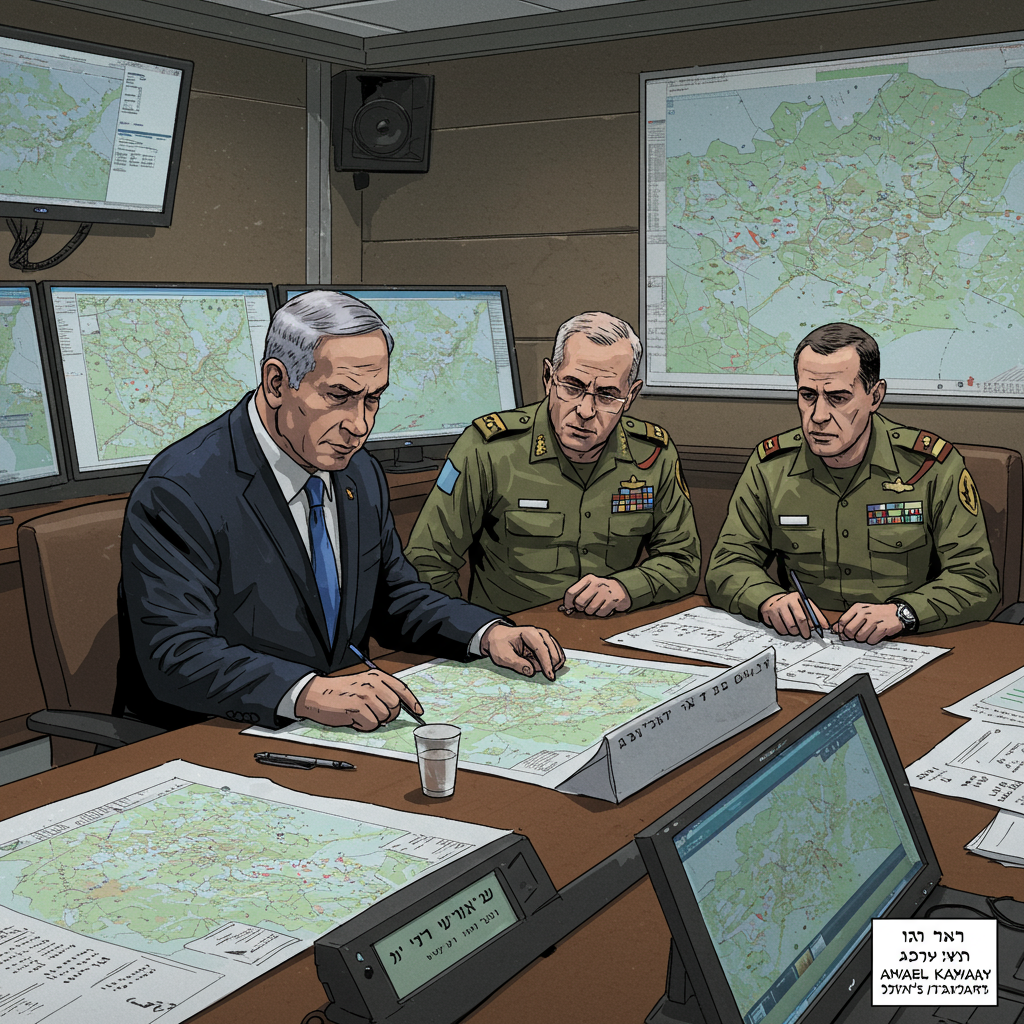Reports from Jerusalem indicate that Israeli military leaders are evaluating potential new strategies for operations in the Gaza Strip. This comes as ceasefire negotiations appear stalled, pushing decision-makers to weigh further military action against declared achievements. High-level discussions are scheduled to address these critical next steps, involving key figures like Prime Minister Benjamin Netanyahu, Defense Minister israel Katz, and IDF Chief of Staff Lt.-Gen. Eyal Zamir.
The possibility of launching a wider military operation, different from previous phases, looms large if a breakthrough in hostage negotiations is not achieved in the coming days. This potential shift in strategy reflects an ongoing debate within the Israel Defense Forces (IDF) about the most effective path forward after months of intense conflict and stalled diplomatic efforts.
Israel Debates Next Steps Amid Stalled Talks
Inside the IDF, senior officials are engaged in a crucial internal debate. One perspective advocates pressing forward militarily, suggesting more action is necessary to achieve Israel’s war objectives. Another viewpoint contends that the main goals of the campaign have largely been met, suggesting it might be time to shift focus or declare victory based on accomplishments to date.
Military sources detail these claimed accomplishments, including significant damage to Hamas’s military infrastructure and the targeted killing of senior commanders. Notably, the commander of the Gaza City Brigade, Izz al-Din al-Haddad, remains a specific target for the IDF and Shin Bet (Israel Security Agency). Israeli forces also report dismantling extensive tunnel networks and weapons systems and gaining control over more than half of the territory within the Gaza Strip. Major smuggling routes from the Sinai Peninsula and the Mediterranean have also reportedly been blocked, aiming to sever Hamas’s supply lines.
IDF assessments suggest that Hamas is currently at its weakest point since it took control of Gaza in 2007. This weakened state reportedly forces the group to prioritize diplomatic maneuvering over continued military confrontation on the battlefield. According to one senior defense official, reflections on recent regional conflicts, such as the 12-day exchange between Israel and Iran, reinforce a strategic lesson: understanding the optimal moment to conclude hostilities. This sentiment suggests that tactical gains must be weighed against the strategic costs and potential endpoints of the conflict.
The Prospect of a Wider Ground Operation
Despite claimed successes and assessments of Hamas’s weakened state, some high-ranking officers maintain that a wide-scale ground maneuver is still essential. This proposed action would represent a significant escalation and is predicted to result in the largest displacement of civilians within Gaza since the war began. The human cost of the conflict has already been immense, with widespread destruction and tens of thousands of casualties, according to various international reports. Such an operation would exacerbate the humanitarian crisis.
Furthermore, military sources caution that urban warfare in densely populated areas fortified with tunnels and booby traps would likely lead to substantial IDF casualties. Proceeding with this scenario would require a significant commitment of resources. Officials indicate that it would necessitate deploying five fully manned divisions, a stark contrast to the partial deployments utilized in earlier stages of the campaign. This move would also trigger a new wave of reserve call-ups under Tzav 8, recalling civilian reservists to active duty.
Civilian Evacuations and Public Sentiment
Amid discussions of a wider operation, military sources confirm plans are being discussed for the large-scale evacuation of Gazans from specific key areas. The strategic thinking behind these evacuation plans extends beyond operational necessity. Sources suggest that a mass evacuation, occurring while Hamas is perceived as significantly weakened, could potentially turn public sentiment within Gaza against the group’s leadership. The hardship and disruption caused by displacement might erode civilian support for Hamas, especially if the group is seen as unable to prevent such outcomes or protect the population. However, implementing such plans faces immense logistical and humanitarian challenges.
International Pressure and Diplomatic Impasse
The potential for expanded military action unfolds against a backdrop of increasingly intense international pressure and stalled diplomatic efforts to secure a ceasefire and hostage exchange. Reports indicate Prime Minister Netanyahu’s insistence on negotiating “under fire” is a significant factor in the current impasse. Some accounts suggest Israel might withdraw its negotiating delegation if progress isn’t seen soon, although a smaller team might remain engaged in indirect talks mediated by countries like Qatar and Egypt.
There is a proposed three-phase deal reportedly on the table, mediated by the US, Qatar, and Egypt. The first phase reportedly involves exchanging dozens of hostages (women, children, elderly) for hundreds of Palestinian prisoners, coupled with increased humanitarian aid and partial Israeli withdrawal from certain areas. Subsequent phases would address remaining hostages, further withdrawals, and eventually reconstruction and the return of deceased individuals. However, reaching agreement on these points remains elusive.
Key international partners are expressing growing frustration and applying more concrete pressure. Leaders from countries like France, the UK, and Canada have issued warnings, stating they will not remain “idle” in the face of the humanitarian situation in Gaza. They have explicitly hinted at taking “concrete measures” if Israel does not halt its military operations and significantly increase humanitarian aid access. Furthermore, these leaders, alongside other international bodies, have openly declared their determination to recognize a Palestinian state as part of a two-state solution, signaling a potential shift in diplomatic strategy aimed at influencing the conflict’s trajectory. Criticism has also come from mediators like the Qatari Prime Minister, who attributes the ongoing “catastrophe” and undermining of peace opportunities to Israel’s “aggressive behavior.”
Signs of discomfort are also emerging from closer allies, including the United States. Reports citing senior US officials suggest that a planned visit to Israel by US Vice President J.D. Vance was canceled because Vance did not want the visit to appear as an endorsement of Israel’s extensive operation in Gaza at a time when the US is actively pushing for a ceasefire and hostage deal. While logistical reasons were cited publicly, the decision reportedly underscores Washington’s unease with the current Israeli operational approach.
Strategic Divergence with Key Allies
This period also highlights strategic strains between Israeli leadership and key international partners, notably the United States under President Trump. Initially, the relationship was reportedly closely aligned, with the US supporting Israel’s goal to “finish the job” against Hamas. However, recent weeks have seen a divergence in strategy, particularly as Hamas’s capabilities are reportedly degraded and Iran is assessed as weakened.
Points of contention include fundamental differences in approach towards Iran. While Israeli leadership views the current situation as a potential window for military strikes against Iran’s nuclear facilities, believing this opportunity may be closing as diplomatic efforts proceed, the US administration under Trump reportedly favors pursuing a negotiated deal. Israel has communicated its opposition to any nuclear deal that permits Iran to retain uranium enrichment capabilities, expressing frustration with the US focus on negotiation over military action.
Furthermore, disagreements exist regarding the strategy in Gaza itself. As Israel contemplates or launches new offensives, the US administration is reportedly pushing strongly for a ceasefire and is focused on implementing a post-war plan aimed at rebuilding Gaza. This divergence on the immediate path in Gaza adds another layer of tension to high-level bilateral relations. Other friction points, such as differing responses to Iranian-backed groups like the Houthis, also contribute to the strain on the relationship. While Netanyahu faces political constraints that make an open break with Trump difficult, these strategic differences pose a challenge for both leaders’ foreign policy agendas.
The Unresolved Question of Gaza’s Future
A critical, unresolved issue underlying discussions about future military operations and ceasefire agreements is the question of who will govern Gaza after the current conflict ends. While Hamas may be weakened, analysts point out that neither Israel nor current or incoming US administrations have presented a concrete, workable plan for post-war governance.
Without a clear alternative authority, there is a significant risk of the conflict freezing in place, leaving Gaza devastated, reliant on aid, and without a political horizon for recovery or reconstruction. Experts warn that this scenario could potentially allow Hamas to regroup, re-arm, and potentially resurge in the absence of a viable alternative governing body. Discussions of alternatives to Hamas rule, such as the return of the Palestinian Authority (PA) or the establishment of a transitional international administration, are considered premature or lacking detailed plans. The challenge lies in finding a long-term solution that prevents Hamas’s return while also addressing the governance and security needs of Gaza and its population.
Broader Regional Context and the Iran Factor
The strategic calculus in Gaza is also intertwined with broader regional dynamics and the specific context of tensions with Iran. Recent direct exchanges between Israel and Iran have underscored the potential for wider conflict. Israel’s military leadership claims successful strikes against Iranian targets, describing these operations as complex and achieving “extraordinary results.” Conversely, Iran has conditioned further diplomacy on a cessation of Israeli “aggression” and accountability.
Analysts suggest that 2025 is a crucial year regarding the Iranian nuclear program. The Israeli view that Iran is currently weakened by sanctions and proxy degradation makes it a potentially opportune moment for military action, though this window is seen as diminishing. Diplomatic efforts involving European powers and the US also continue, but fundamental disagreements persist, particularly on issues like uranium enrichment. Navigating the Gaza situation is therefore inseparable from the larger regional security picture and strategic postures towards Iran.
Frequently Asked Questions
Why is Israel considering a new strategy in Gaza now?
Israel is reportedly considering a potentially wider military operation in Gaza because ceasefire and hostage negotiations have stalled. This has led to an internal debate within the IDF about whether current military objectives are achieved or if more force is required. Assessments also suggest Hamas is weakened, potentially creating an opportunity for a decisive blow, though this is debated due to the high potential costs and challenges of urban warfare.
What are the main international pressures Israel faces regarding the Gaza operation?
Israel faces significant international pressure from key partners. The UK, France, and Canada have warned of potential “concrete measures” and explicitly pushed for recognizing a Palestinian state if Israel does not halt military actions and increase humanitarian aid. The US has also signaled discomfort, reportedly leading to the cancellation of a high-level visit, as Washington prioritizes securing a ceasefire and a hostage deal. Mediators like Qatar also criticize Israel’s approach.
What are the key challenges for Gaza’s future governance if Hamas is weakened?
A major challenge for Gaza’s future is the lack of a clear plan for post-conflict governance. Even if Hamas is militarily weakened, there is no readily available or widely accepted alternative authority proposed by Israel or international partners. Experts warn that without a viable governing body—such as a reformed Palestinian Authority or a transitional administration—there is a risk that the conflict could remain unresolved, leading to continued instability and potentially allowing Hamas to regroup over time.
Conclusion
As ceasefire talks falter, Israel’s military and political leadership confronts a complex decision point regarding the future of operations in Gaza. The debate between declaring objectives met and pursuing a potentially costly wider offensive is shaped by strategic assessments of Hamas’s capabilities, the severe humanitarian situation, and the risks to Israeli forces. Adding layers of complexity are mounting international pressures, including potential diplomatic actions and strains in key alliances, alongside the overarching regional context involving Iran. The path chosen will have profound implications not only for Gaza and Israel but also for the broader dynamics of regional security and diplomatic efforts toward a lasting resolution. The fate of hostage negotiations remains a critical immediate factor influencing whether the strategic calculus shifts towards further military action or a potential, albeit uncertain, pause in hostilities.
Word Count Check: ~1150 words



